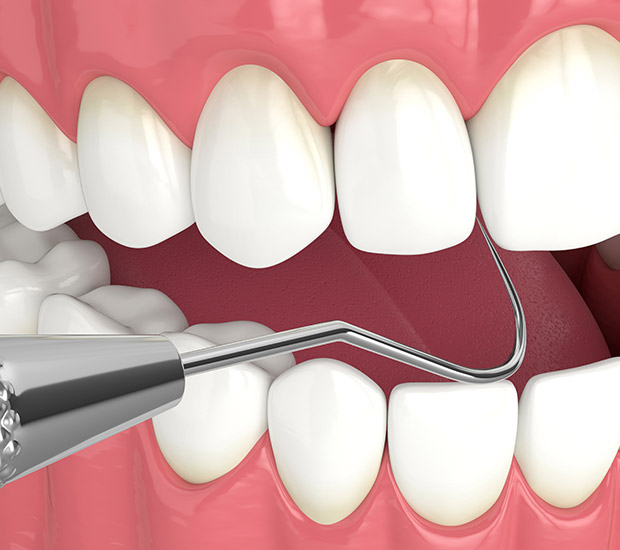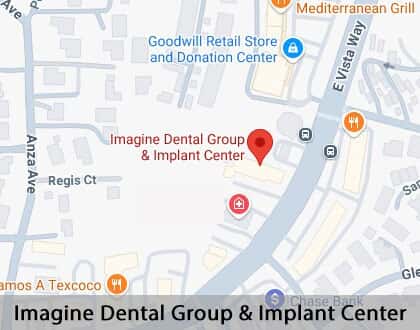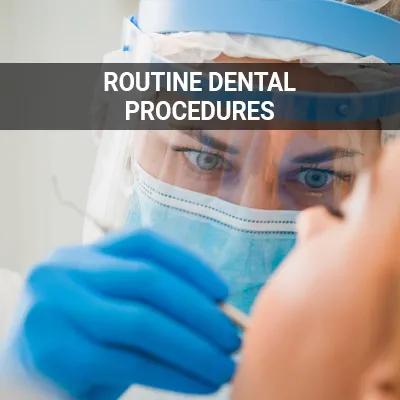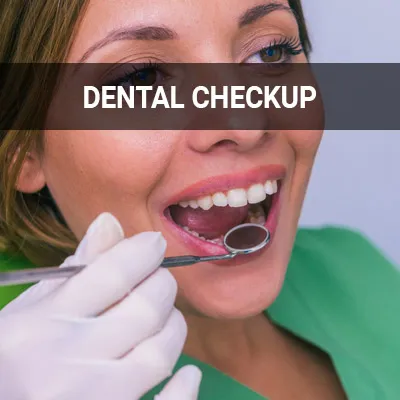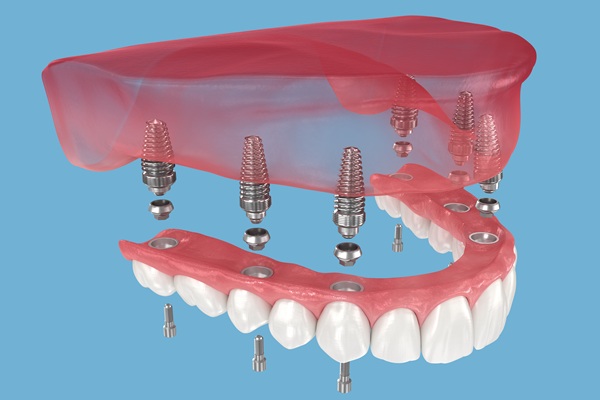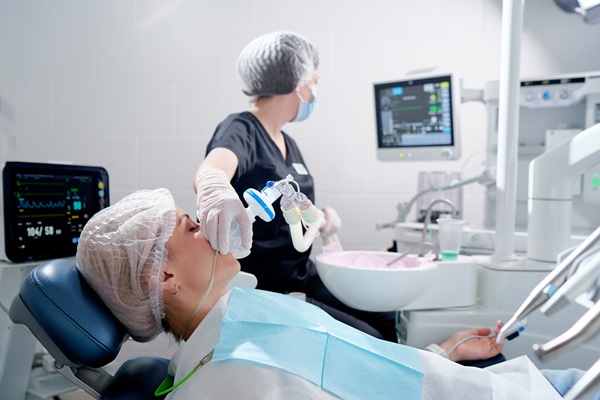Interactive Periodontal Probing Vista, CA
Dentists conduct interactive periodontal probing to measure the depths of pockets around your teeth. Performing this assessment helps you and your dentist understand the current state of your oral health. It can also determine your risk for future gum health and tooth concerns. It can even help identify other underlying health conditions because of the oral-systemic connection.
The interactive part of the diagnostic procedure comes from the knowledge gained by you and your dentist. With this periodontal test, our team at Imagine Dental Group & Implant Center in Vista may be able to deliver an early periodontal disease diagnosis. Imagine Dental Group & Implant Center may also use probing results to create targeted treatment plans to improve your oral and overall well-being.
How Periodontal Test is Performed
Before the periodontal test, the dentist will likely review medical and dental histories, identify any factors contributing to symptoms, and examine the mouth. Returning patients who have undergone their initial consultation and regular checkup will have their record on file and does not need to be reviewed. However, we recommend having a thorough examination of the mouth prior to the periodontal test to check for any abnormalities or easy bleeding.
The test is performed by measuring the pocket depth of the grooves between the gums and teeth. We place a dental probe (a very thin, narrow instrument) beside your tooth beneath your gum line and scan over every tooth. According to the Mayo Clinic, the pocket depth in a healthy mouth is usually between 1 and 3 millimeters (mm). Pockets deeper than 4 mm may indicate periodontitis. It is not easy to clean pockets deeper than 5 mm, so we will go over possible options during the appointment. We will record these numbers on a periodontal chart.
“Pockets deeper than 4 mm may indicate periodontitis.”
Periodontal Charting
Periodontal charting is a part of a patient's dental or gum chart that indicates the state of the teeth and mouth's health. A periodontal chart includes six measurements (in millimeters) that are taken around each tooth. The main reason for periodontal charting is checking for periodontal disease, but it is also beneficial to check for many other oral and systemic health concerns.
What It Reveals
The chart is a pictorial representation of the mouth and includes graphics and information pertaining to the tests conducted during the first appointment. Healthline provides the conditions and issues that a periodontal test and chart reveal:
- areas of decay (cavities)
- missing teeth
- depths of your gum pockets, bleeding points during probing, and gum recession
- abnormalities in your teeth, such as rotations, erosion, or abrasions in your teeth or enamel
- damage to your teeth
- presence of crowns, bridges, implants, and fillings
- attachment of your teeth to the gums
- any movement in your teeth
- any bleeding in your gums
“A periodontal chart includes six measurements (in millimeters) that are taken around each tooth.”
Risk Assessment That Dentist Makes
Periodontal probing and charting allow dentists to assess a patient's risk of acquiring periodontal disease as well as other oral and systemic diseases. A Journal of Periodontology study on risk factors explains: "risk factors may be broadly categorized as: Systemic risk factors - factors that affect the host response to the plaque biofilm, upsetting the host-microbial balance; and Local risk factors - factors local to the oral cavity, which may influence plaque accumulation or occlusal forces." A periodontal chart reveals which factors are in play and their causes.
Risk assessments classify risks in terms of risk factors, risk indicators, and risk predictors. Risk factors include age, tobacco use, diabetes, stress, genetics, pregnancy, cardiovascular diseases, and poor oral hygiene. Risk indicators indicate whether visible risk factors, such as the presence of herpes viruses in subgingival plaque, are cause of an oral or systemic condition. Risk predictors are factors that have no current biological causing agent but have been associated with disease. For example, the number of missing teeth is a risk predictor for disease but may not indicate current periodontitis.
“A periodontal chart reveals which factors are in play and their causes.”
Check out what others are saying about our dental services on Yelp: Interactive Periodontal Probing in Vista, CA
Who Should Receive Periodontal Testing
Although some people may be more at risk than others in terms of acquiring periodontal disease, the American Academy of Periodontology recommends all adults receive annual screenings. A Comprehensive Periodontal Evaluation, or CPE, assesses the patient's periodontal health by examining their teeth, amount of plaque, gums, bite, bone structure, and risk factors. Periodontal testing and the CPE are often done during the initial appointment.
Patients who are at high risk of developing periodontal disease may be asked to undergo testing more than once a year. Factors that contribute to high-risk include:
- Gingivitis
- Poor oral health habits
- Smoking or chewing tobacco
- Hormonal changes, such as those related to pregnancy or menopause
- Recreational drug use, such as smoking marijuana or vaping
- Obesity
- Inadequate nutrition, including vitamin C deficiency
- Genetics
- Certain medications that cause dry mouth or gum changes
- Conditions that cause decreased immunity, such as leukemia, HIV/AIDS and cancer treatment
- Certain diseases, such as diabetes, rheumatoid arthritis and Crohn’s disease
“Although some people may be more at risk than others in terms of acquiring periodontal disease, the American Academy of Periodontology recommends all adults be screened annually.”
Questions Answered on This Page
Q. How is the periodontal test performed?
Q. What does periodontal probing reveal?
Q. What is a risk assessment and what does it show?
People Also Ask
Q. What are common signs of gum disease?
Q. How is gum recession treated?
Q. Why is preventative care important?
Q. What family members may need extra help with their oral hygiene?
Frequently Asked Questions About Interactive Periodontal Probing
Q. When should I receive periodontal probing?
A. The answer depends on the patient. Current guidelines suggest healthy adults receive annual periodontal probing to reduce the risk of gum disease. Patients whose dentists identified higher risk assessment factors may need more frequent periodontal probing to prevent oral health complications.
Q. Will periodontal probing hurt?
A. If you already have periodontal disease, you may experience slight discomfort during periodontal probing. However, little pain is reported during the procedure. If you are concerned about the procedure, you may talk to your dentist about topical numbing creams.
Q. Does periodontal probing make gums bleed?
A. This procedure is designed to check the health of your gums and assess risk factors, including bleeding gums. If your gums bleed during periodontal probing, it is likely a sign that their health is compromised. Bleeding gums are rarely due to probing alone.
Q. What do I do if I have a high risk for periodontal disease?
A. If periodontal probing reveals that you have pockets over 4 mm, you may need frequent in-office cleanings. At this stage, at-home oral hygiene will be difficult. Your dentist can offer specific recommendations but will likely recommend visits every three to six months to prevent disease progression or tooth decay.
Q. What impact can periodontal disease have on my overall health?
A. It is important to work to prevent and treat periodontal disease. Studies have shown gum disease may increase one's risk of other health problems such as high blood pressure, diabetes, and stroke. Some studies even link periodontal disease to cancer, dementia, arthritis, and kidney disease.
Dental Terminology
Call Us Today
If you are looking for more information pertaining to periodontal probing or testing, call us today at 760-407-6719 to learn more or make an appointment.
Helpful Related Links
- American Dental Association (ADA). Glossary of Dental Clinical Terms. 2025
About our business, license, and website security
- Imagine Dental Group & Implant Center was established in 2019.
- We accept the following payment methods: American Express, Cash, Check, Discover, MasterCard, and Visa
- We serve patients from the following counties: San Diego County
- We serve patients from the following cities: Vista, Carlsbad, San Marcos, Oceanside, Escondido, Bonsall, Encinitas, Solana Beach, Fallbrook, Valley Center and Poway
- CA (License #45944). View License Information and Specifics
- National Provider Identifier Database (1659410199). View NPI Registry Information
- Norton Safe Web. View Details
- Trend Micro Site Safety Center. View Details
Back to top of Interactive Periodontal Probing
